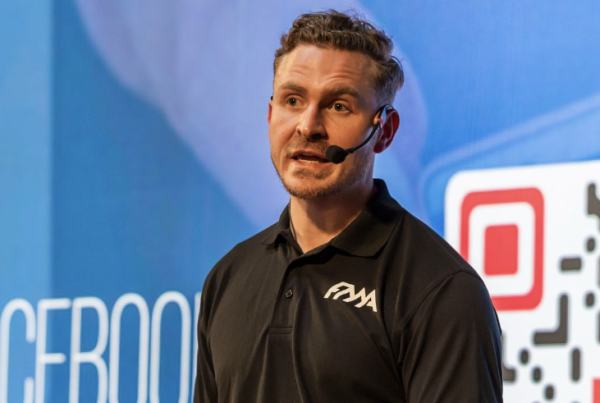The community aspect of group fitness is what makes participants return to class – and remain members of their club. Instructor Mel Morony looks at how to foster the connections that create this sense of community.
The instructor enters the room, a couple of minutes before the class is due to start. They greet their participants who are already waiting for them while they set up their music. As they start their class, they trot out the requisite ‘injuries and medical conditions’ spiel and then ask if anyone is there for the first time. A couple of people timidly raise their hands, so the instructor gives a quick nod of welcome and continues with the class, hoping that the newbies will like the class enough to return the following week. Afterwards, while the instructor is packing up, they check in with the new participants to see how they went. The response ‘Yeah, good’ sounds positive, but could just be politeness. And that is that. Will they be back next week? Maybe, maybe not.
While our group fitness instructor has done all that the gym might have asked them to do as far as delivering a class is concerned, they are running the risk of making their focus all about their product without getting to know the people that the product is being directed at.
As group fitness instructors we are often reminded to build rapport with our people. Seldom, however, is it explained why – and even more seldom taught ‘how’. Generally, if any rapport building training is given to team members, it’s focused on those who sell memberships, and maybe those working at the front desk, with little attention paid to those in other areas of the club.
So, why is rapport building for a sense of community so important?
To understand the importance of rapport building in group fitness we need to look at the reason that a fitness club provides group fitness in the first place. The reason is not to be nice. It isn’t even to give people a better ‘shot’ at achieving their results than if they were to do it by themselves. Rather, it’s to increase the proportion of people that the club will retain as members. From a marketing perspective, it is a lot more economical to retain an existing member than to sign up a new one. One UK study, for example, found that people who participated in group fitness were 26% less likely to cancel their memberships than those who trained alone.
Subsequent studies have discovered that the reason for this had little to do with the product of group fitness itself, but was far more due to the community that is created between the instructor and their participants and also among the participants themselves. Hence, if group fitness is a major retention tool, and part of the way that retention is
achieved is via the community created between instructors and their patrons, then training in ‘how to’ create those bonds may well be just as important as being trained in cycle, Pilates and aqua! Let’s explore three aspects of how
an instructor can create that community between themselves and their participants.
1. Put out the ‘welcome’ mat
The first key to creating community is to ensure that our new participant feels welcome. In retail this is a concept known as the ‘meet and greet’. That ‘hi, how are you?’ that we get when we enter a shop is there for a reason – it makes us feel welcome and acknowledged, hopefully enough to buy something from that shop. As group fitness instructors, depending on what and where we are instructing, we may or may not have a door for someone to walk through – so the welcome needs to start from the minute you spot a new participant, whether that is in the studio you are using or out in the waiting area.
Ensure that your body language is open – avoiding crossing your arms and even your legs if you are seated – as these are perceived as barriers. Make sure that you smile, make eye contact and say ‘Hello’ to the person. If you are already welcoming another new person or helping one of your existing members with something, then it’s understandable that you may not be able to immediately say ‘Hello’ to the newcomer – but you can probably still wave, smile and make eye contact.
Consider the atmosphere as well. Imagine going into a shop that was dead silent – where you could hear everything that the other customers were saying, and they were privy to every word you uttered. Would you want to stay for long enough to purchase something? That atmosphere might be OK in a library, but not for somewhere that wants you to feel comfortable enough to hand over money. Having some background music on can certainly go some way to relieving that discomfort. Imagine that the pre-class time is a party and that you are the host.
After the class, go back to the party. Have some ‘play out music’ for after the cool-down. In classes where I don’t have a quick changeover with another instructor, I will stand by the door and bid ‘goodbye’ to people as they leave. This also gives me the perfect opportunity to check in with any newcomers and suss out how they found the class.
2. Use participants’ names
Using your customer’s (or in our case participant’s) name is usually the ‘go to’ with rapport building training. There’s a reason for that – it works. In today’s world we have so many impersonal interactions and communications on a daily basis that, when someone in a professional capacity uses our name spontaneously, it catches us by surprise.
So, how can we learn names? Firstly, we need to give in order to receive. Personally introduce yourself to the person and then ask for their name. Learning names is similar to learning and remembering a language – you have to use that language. It’s the same with names – you need to use the person’s name in conversation. Aim for three times within the time that they are in your class that day, the first time being the next sentence you say to them. If you find that you need to ask their name again the following week, don’t be embarrassed – they can see that there is one of you and a whole bunch of participants, so they will cut you some slack. Over time you will get to know your participants’ names and it may seem like a simple gesture, but the look on someone’s face when their name is used is priceless.
3. Find points of commonality
Another aspect of rapport building worth focusing on is establishing common ground. This is because ‘people like people like themselves.’ Is there anything you notice about the person in the first 10 seconds of meeting them? Are they wearing distinctive clothing or jewellery? Do they speak with an accent? Ask about it. This is known as a ‘hook’. When they respond, think through any experience you have that relates to what they are talking about. For example, if a patron speaks with an accent, for me it’s gold. As well as meeting people from all over the world in my other job as a tour guide in Melbourne, I love to travel, plus I’m fascinated by linguistics and learning languages. So, wherever a participant may say theyare from, it’s likely that I’ve visited the region or learned a little about it from someone I’ve
met previously. From there, a conversation will form.
In the absence of such an obvious hook, you can create one simply by asking how the person’s day has been. Whether they mention work, family, pets, hobbies, gardening or cooking, you should be able to relate to it. Your own experience does not have to be direct: establishing an indirect point of commonality can also work well. For example, if a participant says that they are a nurse, well, I’ve never been a nurse, but a few of my friends have, so I can refer to them and the experiences they have told me about.
Keeping it professional
Keep in mind that at all times we are in a professional position. Members are not our friends. Hence, it is important to be appropriate about what we disclose. I have covered classes in which participants seemed to know every detail of their regular instructor’s love life, and others in which the front row’ers appeared to have intricate knowledge of the working conditions of the facility. Aside from the fact that the latter example may be in breach of a centre’s code of conduct, we must remember that rapport building needs to be about our members, not about us. We also need to be mindful about keeping within our scope of practice. Hence, if someone discloses something to us that would require counselling, further medical attention or even law enforcement agencies to get involved, it is important that we refer appropriately.
These three simple but effective strategies should provide a good starting point for building rapport with participants. So, in the words of the Lonely Planet’s phrase books, next time you have a new participant, ‘Don’t just stand there, say something!’
Mel Morony is a group fitness instructor based in Eastern Melbourne, Australia. She is passionate about raising
standards in the area of group fitness for both participants and instructors.
This feature was produced in conjunction with Australian Fitness Network.
Where to next? Did you read our tear-jerking account of one fit pro’s work with the homeless?







